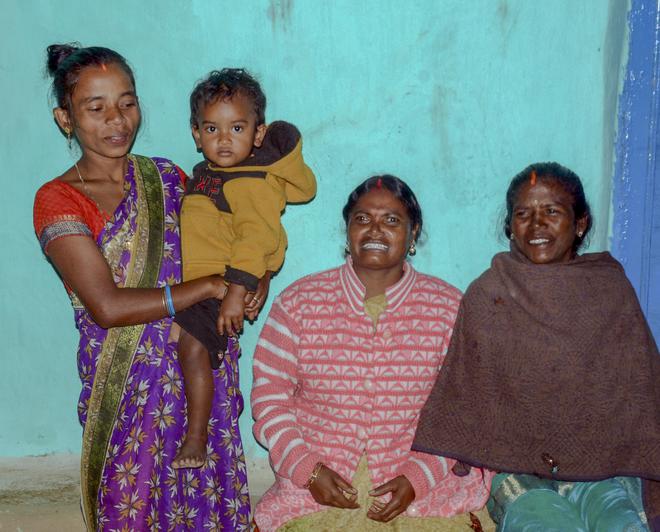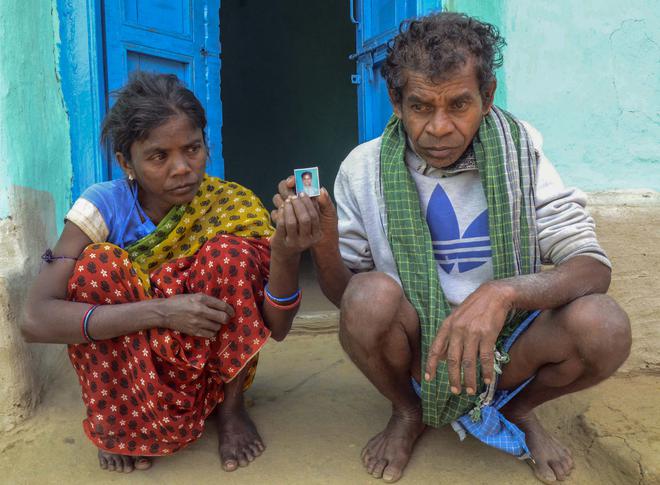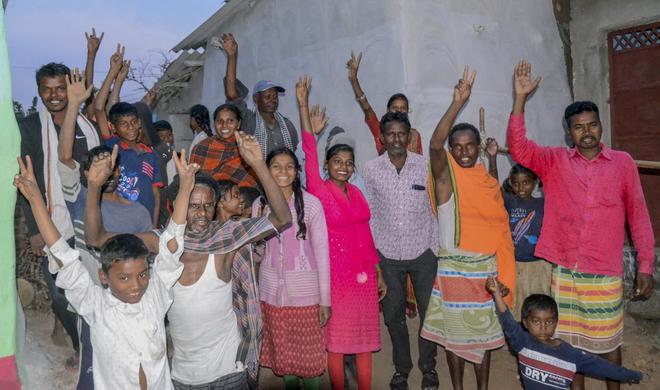Anil Bediya, one of the 41 labourers who were rescued from a collapsed Uttarakhand tunnel after 17 days, survived the ordeal by eating ‘muri’ (puffed rice) and licking water dripping from rocks.
The 22-year-old worker hailing from Jharkhand had a close brush with death after a portion of the Silkyara tunnel on the Brahmakhal-Yamunotri national highway in Uttarakhand collapsed early on November 12.
Uttarakhand:Uttarakhand Chief Minister Pushkar Singh Dham meeting and discussing with the rescued workers and their families in Chinyalisaur.
Also read: 'Practised yoga, took walks to keep spirits up': Rescued workers interact with PM Modi
“Loud shrieks punctuated the air...We all thought we would be buried inside the tunnel and had lost all hope during the first couple of days,” Mr. Bediya told PTI over the phone from Uttarakhand on Nov. 29 morning while narrating their harrowing tale.
“It was a nightmarish ordeal...we licked water dripping from rocks to quench our thirst and survived on muri for the first 10 days,” Mr. Bediya, who is now recuperating at a Uttarakhand hospital, said.
Mr. Bediya hails from Khirabeda, a village on the outskirts of Ranchi which saw a total of 13 people going to Uttarkashi on November 1 in search of greener pastures.

Little did they know what fate had in store for them.
Luckily, only three of the 13 from Khirabeda were inside the tunnel when the disaster struck. Fifteen of the 41 workers hail from Jharkahnd’s Ranchi, Giridih, Khunti and West Singhbhum, where people have erupted in joy after the trapped workers were rescued on Nov. 28 evening.
“Our first hope of survival kindled when the authorities established contact with us after nearly 70 hours,” Mr. Bediya recounted.
According to him, two of their supervisors asked them to drink water dripping through the rocks.

“We had no other option but to relieve ourselves inside the tunnel. Finally, when we heard voices of people communicating with us from outside, a firm belief and hope of survival replaced our desperation,” Mr. Bediya said.
After the first 10 days of gruelling anxiety, supplies, including fruits like bananas, apples and oranges, besides hot meals like rice, dal and chapatis became regular along with water bottles, he said.
“Huddled together, we used to pray desperately for early rescue...finally God heard us,” he said.
His anxiety-stricken mother had not cooked food for the last two weeks, and the family survived on whatever their neighbours provided them with, a resident of the village said.
In Khirabeda, a paralysed Shravan Bediya, 55, whose only son Rajendra was trapped in the Uttarakhand tunnel, was seen celebrating in a wheelchair after the workers were rescued on Nov. 28 evening.

Besides 22-year-old Rajendra, two others from the village — Sukhram and Anil, both in their early 20s — were trapped inside the tunnel for 17 days.
Mr. Sukhram’s paralysed mother Parvati, who was inconsolable since she found out about the disaster, was too happy to express her feelings.
The rescue operation began on November 12 after a portion of the under-construction tunnel on Uttarakhand’s Char Dham route collapsed following a landslide, cutting off the exit for the workers inside.
Timeline of the disaster and the rescue operation at Silkyara
November 12: The labourers get trapped as portions of the Silkyara-Dandalgaon under-construction tunnel on the Brahmkhal-Yamunotri highway collapse following a landslide at around 5.30 am on the day of Diwali.
Arrangements were made to supply oxygen, electricity and eatables to the trapped labourers through air-compressed pipes as multiple agencies, including the NDRF, SDRF, BRO, project executing agency NHIDCL and ITBP, begin rescue efforts.
November 13: Contact is established with the trapped workers through a pipe meant to supply oxygen to them and they are reported to be safe. Fresh rubble keeps falling from above the debris accumulates in an area of around 30 metres and spreads to 60 metres.
November 14: Steel pipes of 800- and 900-millimetre diameter are brought to the tunnel site to be inserted through the rubble with the help of an auger machine for horizontal digging.
However, when more rubble falls from the cavity created by the cave-in, two labourers sustain minor injuries.
November 15: Dissatisfied with the first drilling machine, the NHIDCL asks for a state-of-the-art auger machine, which is airlifted from Delhi to speed up the operation.
November 16: The drilling machine is assembled and installed. It starts working past midnight.
November 17: The machine drills about 24 metres through the 57-metre rubble stretch by the afternoon and four MS pipes are inserted. The process comes to a halt when the fifth pipe hits an obstacle.
Another high-performance auger machine is flown down for the rescue efforts.
In the evening, during the positioning of the fifth pipe, a big cracking sound is heard in the tunnel. Fearing the possibility of further collapse in the vicinity, the operation is suspended immediately.
November 18: Drilling does not resume on Saturday as experts feel that the vibrations created by the diesel-driven 1,750-horsepower American auger inside the tunnel might cause more debris to collapse, posing a risk to the lives of the rescue personnel.
Alternative options are explored by a team of officials from the PMO and experts who decide to work on five evacuation plans simultaneously, including vertical drilling through the top of the tunnel to rescue the trapped labourers.
November 19: Drilling remains suspended while Union Minister Nitin Gadkari who reviews the rescue operation says boring horizontally with the huge auger machine appeared to be the best bet.
November 20: PM Narendra Modi speaks to CM Pushkar Dhami over the phone to take stock of the operations.
However, the team is yet to resume the horizontal drilling that got suspended after a boulder appeared to block the progress of the auger machine.
November 21: Rescuers release the first video of the labourers trapped. The workers, wearing yellow and white helmets, are seen receiving food items sent to them through a pipeline and talking to each other.
Two blasts are set off at the Balkot-end of the tunnel, beginning the process of drilling another tunnel - an alternative to the Silkyara-end option. But experts said the approach could take up to 40 days.
The NHIDCL resumes overnight the horizontal boring operation from the Silkyara end that involves an auger machine.
November 22: Horizontal drilling of 800 mm diameter steel pipes reaches about 45 metres with only 12 metres remaining of the around 57-metre debris stretch. Ambulances are kept on standby.
However, in a late evening development, the drilling hits a hurdle when some iron rods come in the way of the auger machine.
November 23: The iron obstruction that had caused a delay of six hours in the drilling is removed. Officials say the 48-metre point has been reached by the drill. But boring through the rubble is put on hold again apparently after cracks appeared in the platform on which the drilling machine rests.
November 24: The 25-tonne machine is restarted and drilling is resumed. However, in a fresh hurdle, the drill hits a metal girder halting the operation again.
November 25: The blades of the auger machine drilling through the rubble are stuck in the debris, forcing officials to consider switching to options that could drag on the rescue by several days, even weeks.
Officials now consider two alternatives: manual drilling through the remaining 10-12 metres of the rubble or drilling down 86 metres from above.
November 26: Vertical drilling of 19.2 metres is done to create an alternative escape route. As the drilling progressed, 700-mm wide pipes were being inserted to create an escape passage.
November 27: Rat-hole mining experts are called in to help with rescuers required to dig through horizontally around 10 metres of rubble. Simultaneously, vertical drilling from above the tunnel has reached a depth of 36 metres.
November 28: Rescue workers break through the last stretch of the rubble at about 7 p.m. NDRF and SDRF men enter the steel chute to reach the trapped workers and start bringing them out on wheeled stretchers one by one. All 41 workers walk out of the collapsed Silkyara tunnel in Uttarakashi.







